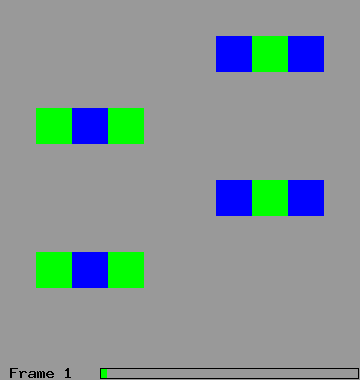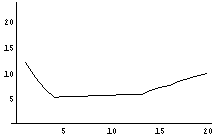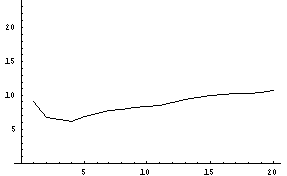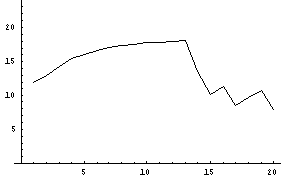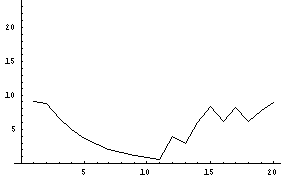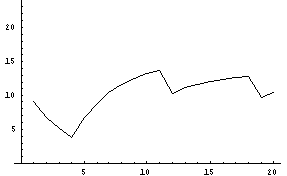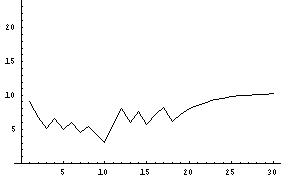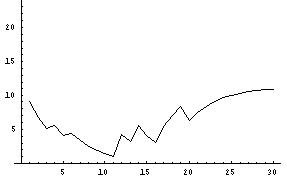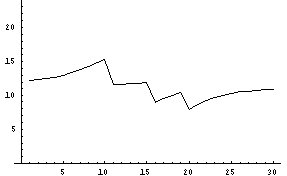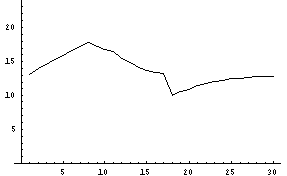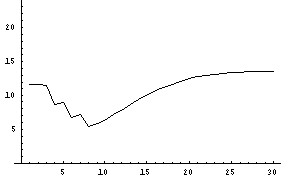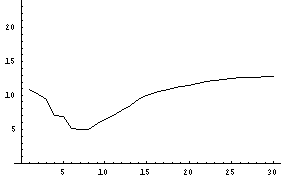The Evolution of Exchange Networks:
A Simulation Study
Phillip Bonacich
Department of Sociology
University of California
bonacich@mediaone.net
ABSTRACT: Networks of exchange opportunities can evolve as
dissatisfied agents search for new partners. Are there stable
networks whose participants do not look for new potential
partners? What do these networks look like? How is the outcome of
this evolutionary process related to the beginning network?
Computer simulations are used to explore how networks of exchange
opportunities evolve when agents can change positions. These
simulations suggest that only networks with high degrees of power
imbalance are unstable and that there are three forms for stable
networks: equal power, indeterminate power, and inconsistent
power (corelessnesss).
Introduction
The experimental study of power within exchange networks has enlightened us as to how power differences develop within exchange networks (for example, Cook et al 1983, Markovsky et al 1988, Markovsky et al 1993, Bonacich 1999). We have excellent models that successfully predict the locations of powerful positions. However, these models require that the network of exchange opportunities itself remain fixed and unchanging. Powerful positions depend on a surplus of dependent positions to which they are inalterably connected. These power differences depend on the immobility of the weaker positions.
Experiments and theories in this area depend on a standard paradigm. A set of actors can engage in a limited number of profitable dyadic transactions, perhaps only one. Actors must choose with whom to transact from among a fixed set of other actors. Each transaction produces a profit that can be divided between the two participants if they can agree on a division. A network describes the set of dyads that can profitably transact. Some actors have more transaction partners than they can possibly transact with; their freedom to choose and reject gives them power.

Figure 1. Two Courses of Network Evolution.
Figure 1 illustrates this point. In this and succeeding diagrams positions are placed on a checkerboard in which neighboring positions (each position has eight potential neighbors) can exchange with one another. I will use this checkerboard representation of exchange networks instead of the more standard graphs, with vertices representing actors and edges exchange possibilities. If the network in the upper left forms, the peripheral positions B, C, and D will gradually lose power by competing with one another for inclusion in exchanges with A. Thus, the network in the upper left will become the network in the upper right, where there are great differences in power. On the other hand, if dissatisfied positions can alter their exchange partners the network may change into the one in the lower left. Research shows that C exchanges with D on equal terms while C has a slight power advantage over D. No position has a marked power advantage. Which path the network follows will depend on the mutability of the network. If the network constraints are based on preferences for specific transaction partners, the network will be immutable and power differences will develop. On the other hand, if the network describes only temporary patterns of ignorance, the network is likely to evolve in the other direction, toward equality of power.
Consider a second example, a hypothetical situation involving two automobile buyers, Andy and Charles, who are equally interested in an auto offered by Barbara.

Figure 2. A Hypothetical Network.
Barbara has a power advantage because of the competition between Andy and Charles. But, suppose that Andy explores the auto market and meets two sellers, Dianne and Eve, in whose autos he is also interested. The power distribution for the new network, represented in Figure 3, is quite different. Andy, who now enjoys a power advantage over Diane and Eve, no longer has a reason to compete with Charles, and so Barbara’s power is reduced.

Figure 3. The Evolution of a Network.
This is not, of course, the end of the story. Diane and Eve are now dissatisfied, and this may lead to further changes. What happens when such changes are allowed?[i] These five actors may be embedded in a larger network, illustrated by Animation 1. In this animation networks identical to Figure 1 are embedded in a larger network in which there are twelve positions configured as four triads. In two of the triads, a single buyer (blue squares) is dominant because he has two competing sellers; in the other two it is the sellers (green) who are powerful. Each triad is unstable. Animation 1 shows 40 moves of the twelve actors. The rules will be described in more detail later in the paper; suffice it to say, dissatisfied players move.
Click browser STOP button to stop animation; click browser RELOAD/REFRESH button to start animation.
|
Animation 1 |
In frame 4, a blue square in the upper right, competing with another blue square, moves. In the next frame a green square in the lower left, competing with another green square, also moves. By frame 25, all actors are members of dyads. Despite all the changes, the two blue and two green squares initially at the centers of their triads have not moved.
The end result is that there are no unequal bargaining situations and no competition: buyers and sellers are paired up. However, do all bargaining networks evolve in such as equable manner when actors can change their positions within an exchange network? What are the characteristics of stable networks? How is the outcome of the evolution related to the properties of the starting network? These are some of the questions to be examined in this paper.
Note that two kinds of stability are being discussed. As long as the network of exchange opportunities does not change, the outcome for the network in Figure 2, in which Barbara has a high degree of power over Andy and Charles, is stable; further bargaining will not reduce Barbara's power. On the other hand, if the actors are permitted to find new exchange relations and potential partners are available, this outcome is not stable; Figure 2 converts to Figure 3. On the one hand (stability-1), we have the stability of an exchange pattern within a fixed network of exchange opportunities, while on the other hand (stability-2) we have networks in which there are no dissatisfied actors who are motivated to transform the network of exchange opportunities itself. This paper will be concerned primarily with developing a model for stability-2.
I will examine these issues using a very simple computer simulation. The simulation mirrors the conditions under which experiments in exchange networks have been conducted and embodies some of the findings from this research. A set of simulated actors has a sequence of opportunities (games) to engage in mutually profitable transactions with their neighbors. There may or may not be further constraints on who can transact with whom (in Figures 2 and 3 and Animation 1 buyers cannot transact with each other and sellers cannot transact with each other). Pairs of actors may divide fixed numbers of points that constitute their earnings. Actors make offers to those with whom they can transact. Whenever two actors each receive their best offers from each other they transact and the process is repeated with the remaining network members until no further transactions are possible. Inconsistent offers in the simulation were resolved by "splitting the difference." An actor omitted from one game raises his offers to others in the next game. Actors included in exchanges make offers to others in the next game that give themselves the same profit.
Figure 4 shows a variety of exchange networks whose emergent distributions of power are well understood, through experiments or computer simulations.

Figure 4. Illustrative Networks (clockwise, from upper left):
Hourglass, Square, Dual-Star, Star, Tee, Four-Chain.
In the Hourglass network all exchanges occur and no position enjoys a substantial power advantage. In the Square network, where all pairs of positions can exchange, all positions are equal in power. In the Dual-Star network C and D have a large power advantage over their trading partners and never trade with each other. In the Star network A has power. In the Tee network B has power over A and C, D and E are equal in power, and B and D don't exchange. In the Four-person Chain B and C rarely exchange with each other and have small power advantages over their neighbors A and D.
Using Cellular Automata
The simulations reported in this paper use cellular automata: the actors are represented by squares on a two-dimensional surface. Actors can trade only with other actors occupying one of the eight neighboring squares. To eliminate any "edge" effects, the board is a torus, in which the top and bottom and left and right are connected.
There are advantages to using cellular automata in simulations of networks. Cellular automata produce images that are easy to visualize and understand. Simulations with cellular automata can incorporate simple rules for forming and dissolving network ties and for network change: a tie exists between neighbors, and movement within a lattice represents network change. The length of the movement is an index of the amount of change in position. Since relationship and distance are associated, the cellular automata automatically produce a multidimensional scaling of cliques and their relationships. The images produced by cellular automata make use of our abilities to recognize and interpret visual patterns. Moreover, one can make use of the voluminous literature on cellular automata (Wolfram 1986; Toffoli 1987; Gutowitz 1990; Goles and Martinez 1999).
A cellular automata can exist in any number of dimensions, and the definition of neighbor can vary. For example, in two dimensions neighbors can be defined as pairs of cells sharing at least a corner. This is a Moore neighborhood, and each cell has eight neighbors. Or, a neighbor could be another cell sharing an edge. This is the von Neumann neighborhood, and each cell has four neighbors. In a three-dimensional cellular automata, a cell has twenty-six other cells with which it shares at least a corner, twelve neighbors with which it shares at least an edge, and six neighbors with which it shares a face.
A two-dimensional cellular automaton has definite limitations for the representation of networks and of network change. First, the degree of a cell is constrained. Depending on how a neighbor is defined, a cell can have a maximum of four (von Neumann neighborhood) or eight (Moore neighborhood) connections. This can be a serious limitation. No one can be related to all the members of a group of size 10 or larger.
Moreover, there is also a limit on the maximum number of neighbors of a cell that are in turn unconnected to each other, and to the number of cells all of whom are connected to one another (a clique). The maximum number of cells unconnected to each other but connected to the same cell is four in a two dimensional cellular automata whether the Moore or Von Neumann neighborhoods are used. Thus, for example, a Star pattern with five or more peripheral positions connected to one central position cannot be represented in a two dimensional cellular automata. This limits the degree of power imbalance that can exist in a network represented by cellular automata. A clique is defined as a set of people among whom all pairs re related. In a two dimensional cellular automata no clique can have more than four members if a Moore neighborhood is used and no more than two with a Von Neumann definition of neighborhood.
Another potential problem is that there is a strong tendency toward transitivity. Cells that share a neighbor are in turn connected to one another 3/7 of the time in a Moore neighborhood. This means that actors will tend to acquire and lose sets of connections simultaneously when they change location in a network; if an actor acquires a connection to another actor he is also likely to acquire some of that actor's connections, and when he loses an connection to another actor he is likely to lose others of that actor's connections. This is a constraint not involving the types of networks that can be displayed in cellular automata but in the types of changes that will occur.
This latter constraint can be an advantage rather than a problem. Many relations have a tendency to be transitive. When one moves or changes jobs, one loses and gains sets rather than single relationships. Becoming someone's friend, or enemy, means acquiring a new set of friends or enemies. A moderate degree of transitivity may be more realistic than the assumption of complete independence in a computer simulation.
The other limitations in the two-dimensional cellular automata can be removed by increasing the number of dimensions. Let N be the number of dimensions in the cellular automata. Neighbors are not separated from each other by any intervening cells and share at least k dimensions, where N > k >= 0. For example, in a two-dimensional cellular automata k = 1 for Von Neumann neighbors and k = 0 for Moore neighbors. The number of neighbors H of a cell is a function both of N and k. Note that for as few as five dimensions a cell can have hundreds of neighbors.
![]()
The maximum number of neighbors of a cell who are in turn unconnected to each other also increases with the number of dimensions. When a neighbor is defined as another cell that shares at least a corner (k = 0), the maximal number of mutually unconnected neighbors of a cell is 2N, and when neighbors must be similar on all but one dimension (k = N-1), the maximum is 2N. Higher dimensional cellular automata can easily represent graphs in which a large number of unconnected vertices connect to one vertex. For example, if N = 5 a cell can have 32 unconnected neighbors.
The limitation on the maximum clique size, which is a problem when the number of dimensions N is small, ceases to be a problem as N increases. Let C(N,k) be the maximum clique size in an N dimensional cellular automata when neighbors must share k dimensions. This value also grows without limit as N increases.
![]()
As discussed before, the transitivity associated with a cellular automata representation of a network can actually be an advantage in the simulation of network change. However, as with the other constraints of cellular automata, the degree of transitivity is under the control of the researcher because it decreases with N. Let E(N) be the proportion of pairs of neighbors of a cell that are in turn neighbors of each other when the neighborhood is defined in the most extensive way (k = 0). It can be shown that:
![]()
It is clear from this formula that the transitivity associated with a cellular automata can be as low as one wants, since E(N) approaches zero as N increases.
In summary, by increasing the number of dimensions any network can be represented by cellular automata. Moreover, limitations in the types of changes that can occur in a network are also reduced as the number of dimensions increases. On the other hand, constraints on network change can also be useful in that they mirror situations in which changes in networks are correlated. Increasing the dimensions beyond two loses something; the network can no longer be represented visually on a page. However, the other advantages remain. The cellular automata still incorporates both network position and network change in a geometric framework that makes the interpretation of simulation results easier.
As Axelrod (1997: 4-6) has pointed out, simulations should be judged by truthfulness, not accuracy. Their purpose is to gain insight. Simulations are most useful when the complexity is in the results, not in the assumptions. Simulations have a theoretical purpose. They are most useful when complicated, unanticipated, and testable results are consequences of a few powerful assumptions. The assumption of a cellular automata geometry is convenient and simple. I am not claiming that real networks are embedded in cellular automata. All I require is that the assumption not get in the way of the consequences of the model.
Simulations described in this paper are different from exchange experiments in another important way: unlike in experiments, simulated actors can change their network positions. Actors are assumed to follow a very simple win-stay/lose-change strategy with respect to movement. Actors do not change their position if they earn more than a certain minimum. I am also assuming a very uninsightful actor. Actors whose earnings fall below the minimum randomly pick a neighboring square, which they move to if it is unoccupied. This actor does not select the position to which he moves on the basis of its worth; he moves blindly and randomly, quite possibly to a worse position. This is consistent with the assumption that the network of exchange opportunities is a consequence of the limited knowledge of the participants.
Exchange networks can describe two very different types of constraints on exchange. On the one hand, an exchange network could represent the structure of preferences among a set of actors. For example, the Tee network in Figure 4 could represent a set of buyers and sellers of, say, automobiles, where A, C and D are buyers and B and E are sellers. A connection in the graph would represent those pairs in which a buyer is willing to pay more for the seller's car than the seller's reservation price. In this case, the network is just as immutable as the preferences of the actors. On the other hand, the network could represent knowledge of others or proximity or some other historically determined or accidental feature of the situation. In this interpretation any set of relations among the actors is possible although only one is currently actualized. Buyers may be aware only of sellers in their neighborhood. Men and women who come in contact with each other for some other reason are all possible romantic partners.[ii]
I will be exploring the consequences of this second type of constraint: lack of information reflecting past historical "accidents." This allows the greatest scope for the effects of network change. When there is complete information and the networks reflect inalterable and knowledgeable preferences for specific interaction partners, the dynamics described in this paper will not occur.
Types of Power in Networks
The core is the fundamental solution concept for cooperative games (Owen 1995:218). The core is based on the assumption that no subset of players should accept any less than their characteristic value -- what they can guarantee themselves regardless of the actions of those not in their subset. Bonacich and Bienenstock (1992) have shown that in exchange networks one need only consider subsets of size two.
Bonacich (1999) has shown that if actors use the following idealized rules in a repeated network exchange game, only outcomes in the core are stable:
- Actors who are excluded from an exchange raise their offers to others in the next game.
- Actors who are included in an exchange make offers that allow them an unchanged profit.
- All offers made by actors to others are equal in value (to themselves).
- An actor leaves a current partner if and only if he receives a strictly superior offer from another.
In this context stability means that if an outcome is in the core and if actors use these four principles, then neither the exchange pattern nor the distribution of rewards in the next game will change (stability-1). This implies that, in the long run, outcomes will be in the core. Moreover, if outcomes are in the core, distributions of rewards can be found through the following procedure:[iii]
The following definitions will be used.
E = the set of edges in a network
S = the set of positions in a network
v = the maximum number of trades possible in the network.
{Mi} = the set of maximal trading patterns in the network. All these trading patterns consist of v edges.
M =
Mi, the union of the maximal trading patterns. M is a subset of E. The set M of edges used in one or more maximal trading patterns will imply a partition of the set S into mutually exclusive sets, where all pairs of positions in the same set are mutually reachable by paths in the set M.
{Si} the sets of mutually reachable positions. These are disjoint subsets of S. I will call each set along with its relations in M a component of the network. There may be just one component.
Consider, for example, the Tee network of Figure 3. There are
two maximal trading patterns, each with two trades: M1
= {A-B,D-E}; and M2 = {B-C,D-E}.
M = M1![]() M2 = {A-B,B-C,D-E}.
This implies that there are two connected components S1
= {A,B,C} and S2 = {D,E}.
M2 = {A-B,B-C,D-E}.
This implies that there are two connected components S1
= {A,B,C} and S2 = {D,E}.
We will now confine the definitions to one component with n positions and m edges. Let v now be the maximum number of trades in this one component. Let A be an m+1 by n matrix in which aij = 1 if edge i contains position j, aij = 0 otherwise. The last row of A consists entirely of 1's. The column vector w has m+1 elements; wi = 1 for i# m; wm+1 = v.
For example, in the Tee network, for the component consisting of positions A, B, and C, the A and w arrays are:

For the second component, consisting of positions D and E, the two arrays are:
![]()
Exact solutions in the core must satisfy the following equations (Bonacich 1999):
![]()
The type of exchange network depends on the solution to this set of equations. Does it have a solution? If it does, is there just one or an infinity of solutions? If there is just one solution, does it imply equal or unequal power? The following diagram shows the possibilities and the types of power distribution within a component.

Figure 5. Solutions to Equation Ax = w and Types of Power Exchange Networks.
I CORELESS COMPONENTS
If the equations have no solution there is no possible outcome that does not leave a pair of actors who are better off trading with each other than with their current partners. As a consequence no exchange pattern will be stable.
II STRONG POWER COMPONENTS
In this case the equations have a unique solution consisting of ones and zeros. Some positions enjoy very high (complete) power at the expense of other positions.
III EQUAL POWER COMPONENTS
The equations in this case have a unique solution in which every value is 1/2. The network dynamics act to eliminate inequalities over time.
IV INDETERMINATE POWER COMPONENTS
In this case the equations Ax = w have an infinite number of solutions. The network does not exert a strong influence on power, although some small differences in power due to relations between components may exist. Type IV includes Markovsky's weak power (Markovsky et al 1993).
Table 1 shows the component types for the networks in Figure 4.
Table 1. Component Types for the Networks in Figure 4.
Weak Power Differences -- Two Solutions in Small Networks
Strong power components (type II) can evolve in two very different directions, toward equality of power (types III and IV) or corelessness (type I), in which the instability of the exchange pattern may be disguised by equality in average earnings.
To illustrate the difference, consider the evolution of two
different networks. Figure 6 shows the average rewards to all
positions in the 5-Star network (a central position, C,
with four peripheral positions, A, B, D, and
E, in a simulation with twenty games. This and succeeding
diagrams show moving averages of gains in the last four games. To
be consistent with the experimental literature, exchanges are
worth twenty-four points. All positions start with an average
gain of twelve. In the end all positions are approximately equal
in power, as measured by earnings.
| Position A
|
Position B
|
| Position C
|
Position D
|
| Position E
|
Figure 6. Average Earnings of Positions in 5-Star Network with Four Peripheral Positions.
Now suppose we look at the Dual-Star network, with two powerful central positions position, C and D, and four peripheral positions. Figure 7 shows the outcomes for all positions when change in the network is allowed. Again, in the end all positions eventually earn approximately the same amount.
Position A
Position B
Position C
Position D
Position E
Position F
Figure 7. Average Earnings of Positions in Dual-Star Network.
However, the process through which equality is achieved is quite different in the two networks, as illustrated in Animations 2 and 3.
Click browser STOP button to stop animation; click browser RELOAD/REFRESH button to start animation.
 |
 |
|
Animation 2 |
Animation 3 |
Animation 2 shows one simulation of change in the Star network, where, if there were no movement, the central position would have enjoyed great power. By frame 4 one of the weak peripheral actors has moved, and by frame 5 two other weak actors have moved as well. The previously central position is now a potentially powerless peripheral member in a three-person chain, but in frame 6 its centrality has been restored through the random movement of other positions. In frame 10 there is a stable four-person chain (type IV), with weak power differences, plus an isolated individual. This is unstable and by frame 13 changes into an unstable three-person chain (type II) and a dyad (type IV). In frame 24 one of the weak positions in the chain breaks off and in frame 33 there is a stable pattern involving a triad (type I) and a dyad (type IV).
In the Dual-Star network of Animation 3 the two central positions are potentially the most powerful. In frame 10 two weak peripheral positions have moved. This leaves a stable four-person chain (type IV) and two isolated individuals, an unstable pattern. In frame 29 one of the wandering isolates joins the four-person chain to form a five-person chain, which is also unstable because of the great power differences (type II). In frame 31 one of the low-powered positions breaks off. By frame 34 the stable pattern of a four-person chain (type IV) and a dyad (type IV) has formed.
In the Star pattern the apparent stability of the network disguises underlying instabilities in the pattern of exchanges and in rewards; in every round someone is left out in the triad component. In small networks in which all relationships are of equal value the type of outcome will be determined simply by whether there is an even or odd number of actors. Networks with an odd number of actors will inevitably contain a coreless component. This simple principle breaks down, however, when relationships are of unequal value, as they are in the real world.
Instability in Bipartite Networks
In Animation 1 the starting network consisted of a set of type II components, with large power inequalities. When movement was allowed the outcome was a set of components within which power was approximately equal (type IV). Are the results always so equable?
A bipartite network is one in which all existing connections are between members of two different categories. The buyer-seller networks of Animation 1 are bipartite because two members of the same category are never potential exchange partners.
Animation 4 is also initially configured as a set of unstable triads consisting of either a buyer and two sellers or a seller and two buyers. However, in Animation 4 there are fewer blue than green squares. The results are dramatically different. No stable configuration is ever reached. For example, in the sixtieth and concluding frame the triad in the lower left is unstable because one of the green squares has no one with which to trade. The triad in the middle right is unstable because two blue squares are competing for one green square. The five-person network in the upper left can be shown to resolve itself into a dyad plus an unstable triad in which two greens compete for a blue.
Click browser STOP button to stop animation; click browser RELOAD/REFRESH button to start animation.
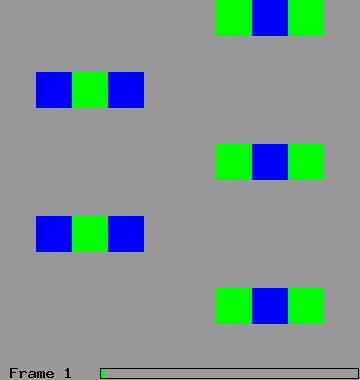 |
Animation 4 |
Social Capital
Social capital can refer to characteristics of the individual or to characteristics of a network. When applied to an individual it refers to the resources that an individual can garner through the members of his personal network. When applied to a network it refers to the capacity of a network. A network whose members trust one another has the capacity for some activities that a network with less trustful measures would lack.
A network in which exploited individuals can change their positions potentially has two forms of social capital that more fixed networks may lack. In Strong Power networks, such as Star networks, many fewer exchanges occur than could occur if the members were arranged differently. The capacity of the network, as measured by the maximal number of transactions that could occur, is sub-optimal. This will be a feature of many, but all, Strong Power networks, in which some positions gain power because others are excluded.
For example, consider the evolution of a Dual-Star network (two central high power positions with four potential exchange partners. The number of exchanges is limited to one in each component. Ten simulations of fifty games each produced a variety of outcomes. Figure 8 shows the increase in the total number of components in these networks from the initial two, with two trades, to a number closer to three, which represented three exchanging dyads.
Figure 8. Increases in Number of Components as a Dual-Star Network Evolves.
Equality in a network may also add to its capacity through the promotion of cohesion among the members. The exploitation that occurs in Strong Power networks may lead to anger and resentment. Figure 9 shows the early increase in inequality in this network, as the powerful central positions come to enjoy the benefits of its privileged position, followed by the decline in inequality, as the network changes its shape.
Figure 9. Standard Deviations of Earnings as a Dual-Star Network Evolves.
Conclusions
Early in the paper I raised three questions:
- If members of exchange networks migrate when they are
dissatisfied with their power, is the result inevitably a
network of equal power?
The answer is no. In networks with two complementary categories of unequal size the members of the larger category remain weak. In other types of networks the results are approximately equal power.
- What are the characteristics of stable networks?
We must distinguish between stability of exchange pattern and earnings within a network of exchange opportunities that does not change (stability-1), and stability of the network of exchange possibilities itself (stability-2). With respect to stability-1, past research (Bonacich and Bienenstock 1995) has shown that only in coreless networks do exchange partners and earnings fluctuate over time within an unchanging network of possible exchange partners. With respect to stability-2, the results of this paper suggest that only Strong Power networks (type II) are unstable. Stable exchange networks are of three types: Indeterminate (type IV), Equal (type III), or Coreless (type I), which in unstable in the first sense but stable in the second.
- How is the outcome of the evolution related to the
properties of the starting network?
Among non-bipartite networks, the outcome depends on whether there are an even or odd number of actors. With an even number of actors the outcome is Indeterminate or equal Power components. Networks with an odd number of actors evolve into Coreless networks. Bipartite networks with equal numbers in the two categories evolve into Indeterminate networks.
Having an even or an odd number of actors in a network is key only when all relations have the same value (Bonacich and Friedkin 1998). If relations can differ in value the simulations become more complex and the final state is both less predictable and ceases to depend on whether there are an odd or even number of actors.
The simulation results appear to be insensitive to the minimum acceptable level of reward that determines whether or not actors move. In the simulations this value was set at 5. In a small set of additional simulations using the Dual-Star network this parameter was set instead at 8. The only affect seemed to be to increase the number of games required for the network to reach stability from approximately 24 to 30.
This paper presents no analytic results concerning network evolution and stability. The author is working on a more mathematical solution using the concept of pairwise stability (Jackson and Watts 1999). Pairwise stability exists in a network if neither member of any connected pair would be better off dissolving the connection and, in addition, there is no pair of unconnected workers both of whom would be better off if the connection existed.
Bibliography
Axelrod, Robert (1997). The Complexity of Cooperation: Agent-based Models of Cooperation and Competition. Princeton, NJ: Princeton University Press.
Basilevsky, Alexander (1983). Applied Matrix Algebra in the Statistical Sciences. New York: North Holland.
Bienenstock, E. J. and Phillip Bonacich (1992). “The core as a solution to negatively connected exchange networks,” Social Networks 14: 231-243
Bonacich, Phillip (1999). “An Algebraic Theory of Strong Power in Negatively Connected Exchange Networks,” Journal of Mathematical Sociology 23:203-224.
Bonacich, Phillip and Elisa Jayne Bienenstock (1995). “When Rationality Fails: Unstable Exchange Networks with Empty Cores,” Rationality and Society 7: 293-320.
Bonacich, Phillip and Noah Friedkin (1998). “Unequally-valued Exchange Relations,” Social Psychology Quarterly 61:160-171.
Cook, K.S., R.M. Emerson, M.R. Gillmore, and T. Yamagishi (1983). “The Distribution of Power in Exchange Networks: Theory and Experimental Results,” American Journal of Sociology 89:275-305.
Doreian, Patrick and Frans Stockman, eds. (1997). Evolution of Social Networks. Amsterdam: Gordon and Beach Publishers.
Gaylord, Richard and Louis J. D'Andria (1998). Simulating Society: A Mathematica Toolkit and Modeling Socioeconomic Behavior. New York: Springer-Verlag.
Goles, Eric and Servet Martinez (1999). Cellular Automata and Complex Systems. Boston: Kluwer Academic Publishers.
Gutowitz, Howard, ed. (1991). Cellular Automata: Theory and Experiment. Cambridge: MIT Press.
Jackson, Mathew, and Alison Watts (1999). “The Evolution of Economic Networks.” Unpublished paper.
Markovsky, Barry, David Willer, and Travis Patton (1988). “Power Relations in Exchange Networks,” American Sociological Review 53: 220-236.
Markovsky, Barry, John Skvoretz, David Willer, Michael Lovaglia, and Jeffrey Erger (1993). “The Seeds of Weak Power: an Extension of Network Exchange Theory,” American Sociological Review 58: 197-209.
Owen, Guillermo (1995). Game Theory (3rd edition). San Diego: Academic Press.
Toffoli, Tommaso (1987). Cellular Automata Machines: A New Environment for Modeling. Cambridge: MIT Press.
Wolfram, Stephen (1986). Theory and Applications of Cellular Automata. Singapore: World Scientific.
APPENDIX A
Detailed Descriptions of the Simulations
The simulation of the exchange process is based on the cellular automata (CA) representation of an exchange network. The programs borrow heavily from Gaylord and D'Andria (1998). A two-dimensional cellular automata is a checkerboard made up of cells that can be occupied by actors. The number of rows and columns are parameters of the CA. To eliminate any "edge" and "corner" effects the top and bottom and left and right sides of the board are "connected", which implies that actors can disappear from one side of the board and reappear on the other. As a consequence, each cell has eight neighbors, those cells to the northeast, north, northwest, west, southwest, south, southeast, and east. An actor placed in a cell can trade with only an occupant of one of these eight cells. The actors can be placed randomly or according to design. In each game players begin by making offers to one another on the division of 24 points. Players excluded from exchange in the previous game raise the values of their offers to others by two points. Players included in exchange make offers to others that would give them what they earned in the last game. Two players each of whom makes each other's best offers conclude a deal, splitting any differences between their offers. The offers of the other players are then examined and further deals concluded until there are no connected pairs remaining. An average gain over the last four games is computed for each player. If this average gain falls below 5 points, the player walks, if this is feasible.[iv]
[i] A recent book
edited by Doreian and Stockman (1997) includes many studies of
the evolution of social networks. However, none of them involves
the evolution of exchange networks.
[ii] Most exchange
networks undoubtedly reflect both preferences and ignorance.
[iii] All transactions
are standardized to have a value of 1.00.
[iv] For the rules
governing walking, see Gaylord and D'Andria (1998, Chapter 1).
